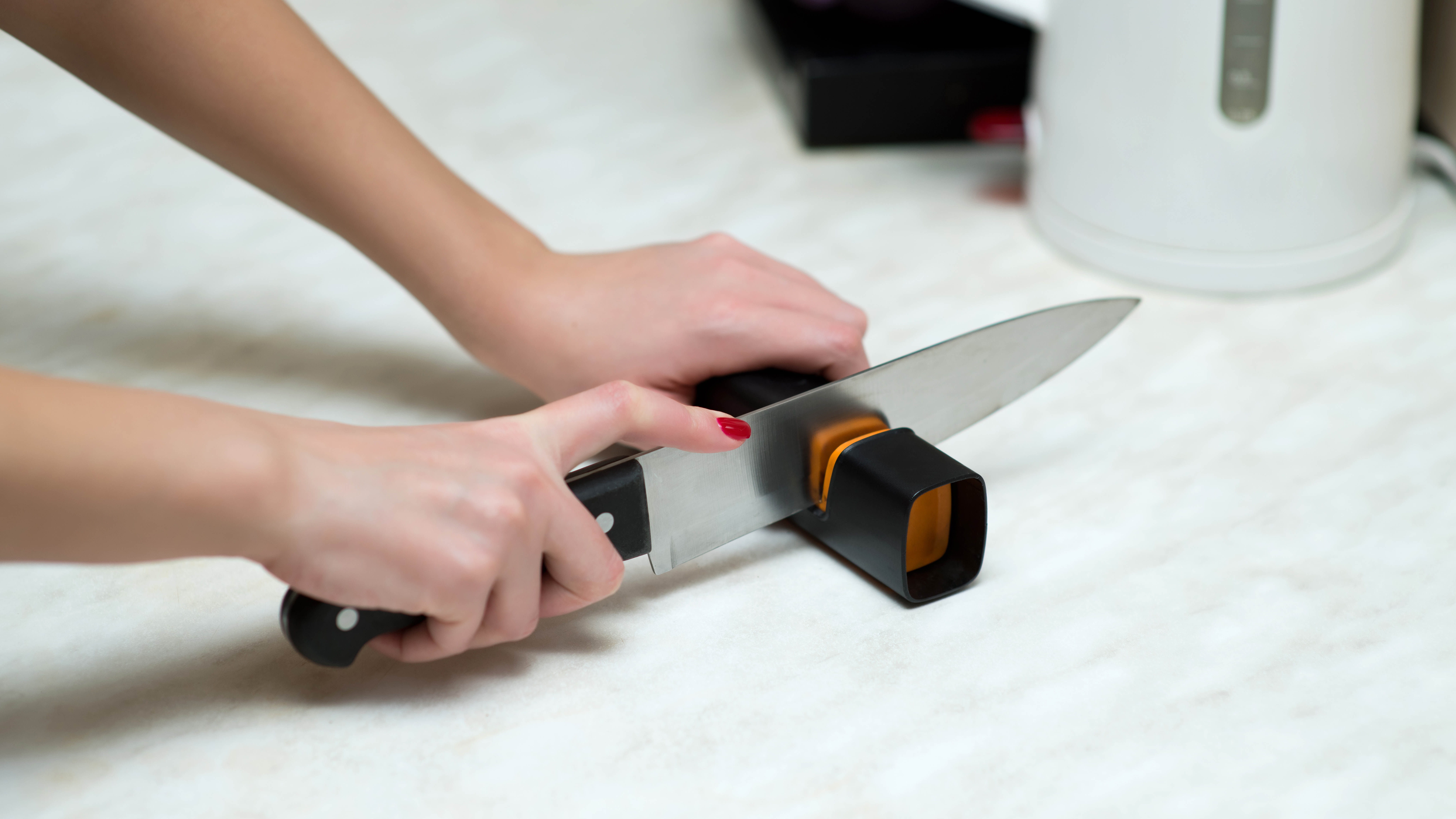7 mistakes that are ruining your kitchen knives
Are you making any of these mistakes with your kitchen knives?

A kitchen knife is such an essential tool that it's easily taken for granted. We use them to slice, dice, mince and chop all kinds of ingredients during our daily food prep, so it's important that we take care of them properly. With everyday use, the blade inevitably dulls and wears. But, did you know that there are things you could be doing that are speeding up the process and making things worse?
There are several common mistakes when it comes to handling, storing and maintaining kitchen knives, which can not only damage the edge of the blade, but also create some safety issues.
We've put together up a list of 7 mistakes that are ruining your kitchen knives; read on to see if you're guilty of any of them, and how to avoid them to ensure your kitchen knives last longer and work better, too.
1. Not sharpening your knives

All knives need sharpening once in a while. This is the case even if you handle them with extreme care and precision. With every use and every contact with the best cutting boards, you’re slowly dulling the blade. Eventually, you will notice the knife won't cut so easily, often tearing items as you (forcefully) saw through.
Not only will this make the task more difficult, it could pose a safety hazard too. More pressure is naturally required when you chop with a dull blade, which increases the likelihood of slipping and accidents.
But, before you go running out to buy a new knife, learning how to sharpen a knife is pretty straightforward, and doing so can help your knife last for years to come. You can either buy a dedicated knife sharpener — both manual and electric options are available, such as the KitchenIQ 50009 Edge Grip 2-Stage Knife Sharpener ($10.50, Amazon). Or you can use a whetstone. In either case, you will want to start with the coarse grit notch/side and then switch to the fine grit notch/side. Don’t forget to hone the blade regularly too — you should hone the blade before of after every use using a steel — this smoothens out small nicks in the blade and will increase the amount of time you can go between full sharpening.
For full guidance and step-by-step instructions, see how to sharpen a knife.
Sign up to get the BEST of Tom's Guide direct to your inbox.
Get instant access to breaking news, the hottest reviews, great deals and helpful tips.
2. Not storing your knives correctly

Chucking your kitchen knives loose in a drawer is a terrible habit. First, the blades will dull and nick as they’re knocked about with other items in there. At the same time, they could do some damage to anything else you’ve stored or even to the draw itself. Leaving knives loose in a draw isn’t exactly safe either. It’s all too easy to cut yourself as you root around for utensils. A sharp blade can be buried and difficult to spot in a busy drawer.
Avoid this mistake, and store your knives properly, There are several options available. (Here are 7 clever ways to store kitchen knives.)
A dedicated knife block can keep your knives separated and organized — some of these even come with built-in knife sharpeners. Magnetic strips which hold the knives in place on the wall are also very popular. If you’ve got young children running around, an in-drawer storage block might be best, such as this Noble Home & Chef Store In-Drawer Bamboo Knife Block ($26.74, Amazon).
3. Putting knives in the dishwasher

We can’t stress this point enough — do not put your kitchen knives in the dishwasher. Dishwashers are the worst thing for knives — here’s why. The high heat and moisture can lead to warping as well as rust. Plus, any wooden handles will swell and crack. The blade itself can dull too from such aggressive detergent.
It’s ultimately a bad idea, even if the tools have polycarbonate handles and say they are dishwasher-safe. These types of knives can deteriorate just as easily and can show corrosion and rust within a few cycles. For example, Victorinox recommend that even their knives with synthetic handles be hand washed, despite being dishwasher safe.
Instead, carefully wash your kitchen knives by hand (while wearing gloves) using warm, soapy water and a sponge. Always hold it via the handle and wipe towards the blade’s edge. Ceramic knives can be rinsed clean under running hot water, while carbon steel should just be wiped with a microfiber cloth. Do not use water on carbon steel, as this metal rusts quickly. Make sure you dry your kitchen knife thoroughly before storing it as well. Do not leave it to air dry.
4. Using a glass or stone cutting board

There’s a huge range of options to choose from when it comes to cutting boards. Materials include wood, plastic, glass, and stone. And while some may look more decorative than others, you should completely avoid glass and stone boards — stone options include the likes of granite and marble. These surfaces are actually harder than the steel blade of your knife and so can blunt it on impact.
Wooden or plastic cutting boards won't be as damaging on your knives and can help the blade’s edge last for longer. These options are also less slippery versus a glass surface, which makes them safer in use. Of course, you will have to learn how to clean a wooden cutting board, but the upkeep is worth the benefit for your knives. Check out our best cutting boards if you want some guidance on which to choose.
5. Cutting incorrect items

Knives come in all shapes and sizes, and each type is designed to suit a different purpose. For instance, bread knives are serrated to help you ‘saw’ through a crusty loaf, while a carving knife is long and slender to help you thinly slice joints of meat. Some knives are multi-purpose as well — chef’s knives can be used for chopping, slicing and dicing.
Always make sure the knife you’re using is suited to the purpose of what you’re cutting. Using the wrong knife can potentially damage it and lead to safety hazards as well. Make sure the knife is adequately sized for the job for the same reason.
Kitchen knives should never be used for any purpose other than food preparation in the kitchen. If you need to cut something around the home, use a more appropriate tool, such as a pair of scissors or a box cutter, and take care in use.
6. Scraping your knife

While it’s convenient to move ingredients from the cutting board to the pan with a swift brush of your knife, it can be a bad habit. If the blade drags against the surface of the board or you scrape it against the metal side of a pan, you’re actually dulling and damaging it. Such contact won’t be helping your cutting board or other utensils either.
You can either use the knife's spine to scrape ingredients away, or buy a dedicated tool to scrape ingredients from your cutting board, such as this Pro Dough Pastry Scraper/Cutter/Chopper ($7.99, Amazon). Some cutting boards are also designed to help you collect and direct your ingredients, such as the Joseph Joseph Chop2Pot Plus Foldable Plastic Cutting Board ($19.99, Amazon).
7. Not gripping your knife correctly

You might have been holding your kitchen knife wrong all this time. While this won’t necessarily damage your knife, it can affect its performance and it can be potentially dangerous in use too.
There are two common ways to grip a kitchen knife. The first everyday-use hold is to grip all fingers and thumb around the handle as close to the bolster and heel as possible — this improves your control. The main thing to remember is not to have a finger pressed directly along the spine of the knife, as this could easily slip.
The second grip-type involves using your forefinger and thumb to "pincer" grip the end of the blade from the top, while the rest of the fingers wrap around the handle as usual. Your index finger should be bent toward the bolster, rather than straight, to create a firm grip with your thumb. Your fingers should never be near the underside of the blade. This grip is often practiced by chefs — who may regularly switch between grips depending on what they're preparing — especially when holding the knife the the blade horizontally to slice something laterally, e.g. filleting a fish.
Both grips are fine, though, and as long as you have your fingers and thumb well away from the blade, you can grip the knife in whatever way feels comfortable.
More from Tom's Guide

Katie Mortram used to be a Homes Editor for Tom's Guide, where she oversaw everything from kitchen appliances to gardening tools, as well as smart home tech. Specializing in providing expert advice for cleaning and home manintenance, she now works as Household Advice Editor for Good Housekeeping.
